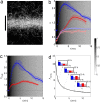Rapid chemotactic response enables marine bacteria to exploit ephemeral microscale nutrient patches
- PMID: 18337491
- PMCID: PMC2393791
- DOI: 10.1073/pnas.0709765105
Rapid chemotactic response enables marine bacteria to exploit ephemeral microscale nutrient patches
Abstract
Because ocean water is typically resource-poor, bacteria may gain significant growth advantages if they can exploit the ephemeral nutrient patches originating from numerous, small sources. Although this interaction has been proposed to enhance biogeochemical transformation rates in the ocean, it remains questionable whether bacteria are able to efficiently use patches before physical mechanisms dissipate them. Here we show that the rapid chemotactic response of the marine bacterium Pseudoalteromonas haloplanktis substantially enhances its ability to exploit nutrient patches before they dissipate. We investigated two types of patches important in the ocean: nutrient pulses and nutrient plumes, generated for example from lysed algae and sinking organic particles, respectively. We used microfluidic devices to create patches with environmentally realistic dimensions and dynamics. The accumulation of P. haloplanktis in response to a nutrient pulse led to formation of bacterial hot spots within tens of seconds, resulting in a 10-fold higher nutrient exposure for the fastest 20% of the population compared with nonmotile cells. Moreover, the chemotactic response of P. haloplanktis was >10 times faster than the classic chemotaxis model Escherichia coli, leading to twice the nutrient exposure. We demonstrate that such rapid response allows P. haloplanktis to colonize nutrient plumes for realistic particle sinking speeds, with up to a 4-fold nutrient exposure compared with nonmotile cells. These results suggest that chemotactic swimming strategies of marine bacteria in patchy nutrient seascapes exert strong influence on carbon turnover rates by triggering the formation of microscale hot spots of bacterial productivity.
Conflict of interest statement
The authors declare no conflict of interest.
Figures




References
-
- Azam F. Microbial control of oceanic carbon flux: The plot thickens. Science. 1998;280:694–696.
-
- Blackburn N, Fenchel T, Mitchell J. Microscale nutrient patches in planktonic habitats shown by chemotactic bacteria. Science. 1998;282:2254–2256. - PubMed
-
- Fenchel T. Microbial behavior in a heterogeneous world. Science. 2002;296:1068–1071. - PubMed
-
- Mitchell JG, Okubo A, Fuhrman JA. Microzones surrounding phytoplankton form the basis for a stratified marine microbial ecosystem. Nature. 1985;316:58–59.
-
- Blackburn N, Azam F, Hågström A. Spatially explicit simulations of a microbial food web. Limnol Oceanogr. 1997;42:613–622.
Publication types
MeSH terms
Grants and funding
LinkOut - more resources
Full Text Sources

